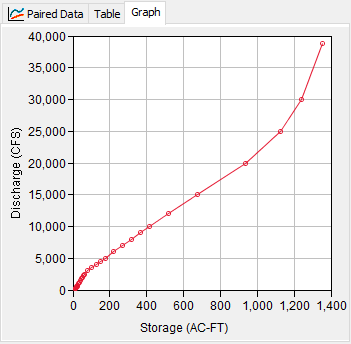Download PDF
Download page Paired Data.
Paired Data
Hydrologic models often require the use of Paired Data to describe inputs that are functional in form. Functional data defines a dependent variable in terms of an independent variable. For most cases, the function must be monotonically increasing which means it only increases and never decreases. Examples of paired data include unit hydrographs and stage-discharge curves. The program separates different types of paired data with different data types. Paired data only has to be entered one time. The data are part of the project and can be shared by multiple Basin or Meteorologic Models.
Creating a New Paired Data Curve
A new curve is created using the Paired Data Manager. To access the manager, click on the Components menu and select the Paired Data Manager menu command. The manager can remain open while you perform tasks elsewhere in the program. You can close the manager using the X button in the upper right corner. At the top of the manager is a Data Type menu. This menu lets you select one of the paired data types supported by the program. Refer to the Preferred data order and internal DSS data type label for different types of Paired Data table for a complete list of Paired Data Types. When a data type is selected, the manager will show all paired data of the same type. The buttons to the right of the paired data list can be used to manage existing data or create new data. To create a paired data curve, press the New button.

After you press the button, the Create A Paired Data window will open where you can name and describe the new curve. A default name is provided for the new curve; you can use the default or replace it with your own choice. A description can also be entered. If the description is long, you can press the button to the right of the description field to open an editor. The editor makes it easier to enter and edit long descriptions. When you are satisfied with the name and description, press the Create button to finish the process of creating the new paired data curve. You cannot press the Create button if no name is specified. If you change your mind and do not want to create a paired data curve, press the Cancel button or the X button in the upper right to return to the Paired Data Manager.
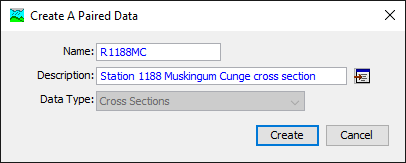
Copying a Curve
There are two ways to copy a paired data curve. Both methods for copying a curve create an exact duplicate with a different name. Once the copy has been made it is independent of the original and they do not interact.
The first way to create a copy is to use the Paired Data Manager, which is accessed from the Components menu. First, select the data type of paired data curve you want to copy from the Data Type menu. Then, select the Paired Data Curve you want to copy by clicking on it in the list of current paired data curves. The selected curve is highlighted after you select it. After you select a curve you can press the Copy button on the right side of the window. A new window will open where you can name and describe the copy that will be created. A default name is provided for the copy; you can use the default or replace it with your own choice. A description can also be entered; if it is long you can use the button to the right of the description field to open an editor. When you are satisfied with the name and description, press the Copy button to finish the process of copying the selected paired data curve. You cannot press the Copy button if no name is specified. If you change your mind and do not want to copy the selected curve, press the Cancel button or the X button in the upper right to return to the Paired Data Manager.

The second way to create a copy is from the Watershed Explorer, on the Components tab. Move the mouse over the paired data component you wish to copy, then press the right mouse button. A context menu is displayed that contains several choices including Copy. Click the Create Copy menu option. A new window will open where you can name and describe the copy that will be created. A default name is provided for the copy; you can use the default or replace it with your own choice. A description can also be entered; if it is long you can use the button to the right of the description field to open an editor. When you are satisfied with the name and description, press the Copy button to finish the process of copying the selected paired data curve. You cannot press the Copy button if no name is specified. If you change your mind and do not want to copy the curve, press the Cancel button or the X button in the upper right of the window to return to the Watershed Explorer.
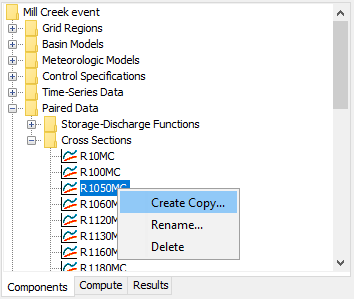
Renaming a Curve
There are two ways to rename a paired data curve. Both methods for renaming a curve changes its name and then all references to the old name are automatically updated to the new name.
The first way to perform a rename is to use the Paired Data Manager, which you can access from the Components menu. First, select the data type of paired data curve you want to rename from the Data Type menu. Then, select the Paired Data Curve you want to rename by clicking on it in the list of current curves. The selected curve is highlighted after you select it. After you select a curve you can press the Rename button on the right side of the window. A window will open where you can provide the new name. You can also change the description at the same time. If the new description will be long, you can use the button to the right of the field to open an editor. When you are satisfied with the name and description, press the Rename button to finish the process of renaming the selected paired data curve. You cannot press the Rename button if no name is specified. If you change your mind and do not want to rename the selected curve, press the Cancel button or the X button in the upper right of the window to return to the Paired Data Manager.

The second way to rename is from the Watershed Explorer, on the Components tab. Move the mouse over the paired data you wish to copy, then press the right mouse button. A context menu is displayed; select the Rename command and the highlighted name will change to editing mode. You can then move the cursor with the arrow keys on the keyboard or by clicking with the mouse. You can also use the mouse to select some or all of the name. Change the name by typing with the keyboard. When you have finished changing the name, press the Enter key to finalize your choice. You can also finalize your choice by clicking elsewhere in the Watershed Explorer. If you change your mind while in editing mode and do not want to rename the selected curve, press the Escape key.
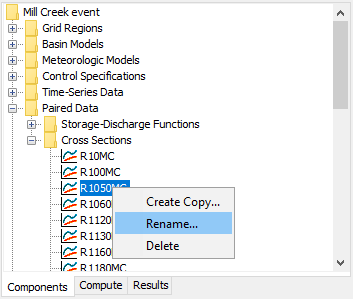
Deleting a Curve
There are two ways to delete a paired data. Both methods for deleting a curve will remove it from the project and then automatically update all references to that curve. Once a curve has been deleted it cannot be retrieved or undeleted. Any references to the deleted curve will switch to using no curve, which is usually not a valid choice during a simulation. At a later time you will have to go to those components and manually select a different curve.
The first way to perform a deletion is to use the Paired Data Manager, which you can access from the Components menu. First, select the data type for the paired data curve you want to delete from the Data Type menu. Then, select the Curve you want to delete by clicking on it in the list of current curves. The selected curve is highlighted after you select it. After you select a curve you can press the Delete button on the right side of the window. A window will open where you must confirm that you want to delete the selected curve. Press the OK button to delete the curve. If you change your mind and do not want to delete the selected curve, press the Cancel button or the X button in the upper right to return to the Paired Data Manager.
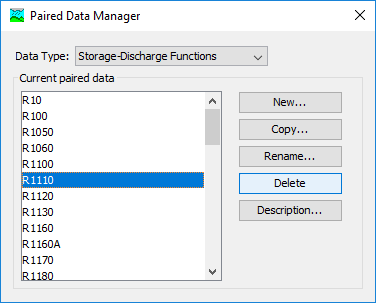
The second way to delete a paired data is from the Watershed Explorer, on the Components tab. Select the curve you want to delete by clicking on it in the Watershed Explorer; it will become highlighted. Keep the mouse over the selected curve and click the right mouse button. A context menu is displayed that contains several choices including delete. Click the Delete menu option. A window will open where you must confirm that you want to delete the selected curve. Press the OK button to delete the curve. If you change your mind and do not want to delete the selected curve, press the Cancel button or the X button in the upper right to return to the Watershed Explorer.
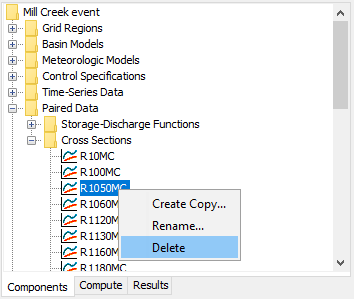
Data Source
The Data Source determines how the data for a paired data will be stored. Data may be entered manually or retrieved from the Data Storage System (HEC-DSS). Manual entry means that you must enter each of the values in the curve or pattern. Data can be retrieved from a DSS file without having to enter the values, but the data must be correctly loaded into the file. The type of properties you specify for the paired data will be determined by the data source, as discussed in the following sections. Compare the following figures to see the difference in entering data for manual or HEC-DSS data sources.
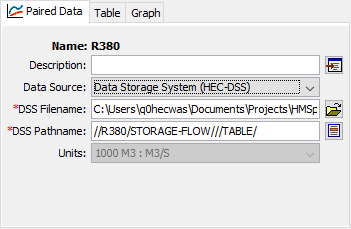

Data Units
The Data Units can only be selected for a manual entry paired data; they are retrieved automatically for the DSS option. Paired data have only two options for units; one for the system international unit system and one for the U.S. customary unit system. For example, a storage-discharge curve can use 1000 cubic meters and cubic meters per second (1000M3 - M3/S) or acre feet and cubic feet per second (ACFT - CFS). The units available in the Units field will depend on the paired data type of the selected component.
Generally, you should choose the data units before entering any data for the component. However, if you change the units after entering data, the data will be adjusted to the new units. There is no units conversion during the adjustment. The values are all kept the same but the assigned units are changed. This is helpful when the data is entered without first checking to make sure the data units are in the desired unit system.
Select the data units for a paired data component using the Component Editor. Access the editor by selecting a paired data in the Watershed Explorer. The Paired Data tab in the Component Editor will display the data units if the manual entry option is selected.
Time Intervals
Unit hydrographs are the only type of paired data that can have a time interval as seen in this previous figure. The time interval can only be selected for a manual entry unit hydrograph; it is retrieved automatically for the DSS option. An interval must be selected from the available choices that range from 1 minute to 24 hours. Generally you should choose the time interval before entering data for the unit hydrograph. However, if you change the time interval after entering data, the data will be adjusted to the new time interval.
Select the time interval for a unit hydrograph paired data using the Component Editor. Access the editor by selecting a unit hydrograph paired data in the Watershed Explorer. The Paired Data tab in the Component Editor will display the time interval if the manual entry option is selected.
Retrieval From a HEC-DSS File
Retrieving paired data from a DSS file requires that the data be loaded in a file. The file can be stored on the local computer or on a network server. It is not a good idea to store the file on removable media since the file must be available whenever the paired data is selected in the Watershed Explorer, and during computes. It is poor practice to store the data in the project DSS file used for storing simulation results. Data for each paired data can be stored in a separate file or one file can contain data for several components. It is best practice to store the DSS files holding gage data in the Project Directory, or a Subdirectory of the Project Directory. The HEC-DSSVue utility (HEC 2003) can be used to load paired data into a DSS file.
When the DSS option is selected, you must specify the Filename to use for the paired data component (as illustrated in this figure). You may type the complete filename if you know it. To use a file browser to locate the file, press the Open File Chooser button to the right of the DSS Filename field. The browser allows you to find the desired file but it is limited to locating files with the DSS extension which is required for all Data Storage System files. Once you locate the desired file, click on it in the browser to select it and press the Select button. If you change your mind, press the Cancel button or the X button in the upper corner of the Select HEC-DSS File window to return to the Component Editor.
You must also specify the Pathname to retrieve from the selected DSS file. You may type the complete pathname if you know it. Each pathname contains six parts called the A-part, B-part, C-part, D-part, E-part, and F-part. The pathname parts are separated with a slash and may contain spaces. The complete pathname, including slashes and spaces, can total up to 256 uppercase characters. The following is an example of a storage-discharge curve pathname:
//BEAR CREEK/STORAGE-OUTFLOW///COMPUTED/
If you do not know the full pathname of the record you wish to use, you can use the Pathname Browser to specify it. You must select a DSS file first before the browser is available. Press the Select DSS Pathname button to the right of the DSS Pathname field to open the browser. The browser initially shows all of the records in the specified DSS file, organized by pathname in the selection table. You can scroll through the list and select a record pathname by clicking on it. Press the Select button at the bottom of the browser to choose that record and return to the Component Editor. If you change your mind and do not want to select a record pathname, press the Cancel button or the X button in the upper right of the Select Pathname From HEC-DSS File window. You can reduce the number of record pathnames shown in the selection table using the Search by Parts filters. A separate filter selection is shown for each of the six pathname parts. By selecting a choice for a filter, only pathnames that match that choice will be shown in the selection table. If you make choices in several filters, only pathnames that satisfy all of the choices will be shown in the selection table.
The program observes a preferred order for paired data. For example, storage-outflow is preferred to outflow-storage. However, the program is capable of using data specified backwards from the preferred order. The program does observe a very strict set of rules for data type and units within the record pathnames. Data cannot be used unless is follows the rules correctly; error messages will be generated if you attempt to use an invalid data type or units. The units of both halves of the paired data must be in the same unit system. The acceptable pathname C-parts for the different types of paired data are shown in the following table.
Paired Data | Description |
Storage-Discharge Function | Defines a storage versus outflow function. The C-part should be "STORAGE-FLOW". |
Elevation-Storage Function | Defines an elevation versus storage function. The C-part should be "ELEVATION-STORAGE". |
Elevation-Area Function | Defines an elevation versus area function. The C-part should be "ELEVATION-AREA". |
Elevation-Discharge Function | Defines an elevation versus discharge function also known as a rating curve. The C-part should be "STAGE-FLOW". |
Unit Hydrograph Curve | Defines a user-specified unit hydrograph. The C-part should be "FLOW-UNIT GRAPH". |
Percentage Curve | Defines a percentage versus percentage function. The C-part should be "PERCENT". |
Cross Section | Defines distance versus elevation function to represent a cross section. The C-part should be "DISTANCE-ELEVATION". |
Inflow-Lag Function | Defines an inflow versus time lag function. The C-part should be "FLOW-LAG". |
Outflow-Attenuation Function | Defines an outflow versus attenuation function. The C-part should be "FLOW-K". |
Inflow-Diversion Function | Defines an inflow versus diversion function. The C-part should be "FLOW-DIVERSION". |
Elevation-Width Function | Defines an elevation versus top width function. The C-part should be "ELEVATION-WIDTH". |
Elevation-Perimeter Function | Defines an elevation versus wetted perimeter function. The C-part should be "ELEVATION-PERIMETER". |
| Diameter-Percentage Function | Defines a diameter versus percentage function, also known as a gradation curve. The C-part should be "DIAMETER-PERCENT ". |
| Area-Reduction Function | Defines a precipitation depth area reduction function. The C-part should be "AREA-FACTOR". |
| Duration-Precipitation Function | Defines a time duration versus precipitation depth function. The C-part should be "DURATION-PRECIPITATION". |
| ATI-Meltrate Function | Defines an antecedent temperature index versus meltrate function. The C-part should be "ATI-MELTRATE". |
| ATI-Coldrate Function | Defines an antecedent temperature index versus coldrate function. The C-part should be "ATI-COLDRATE". |
| Groundmelt Pattern | Defines a groundmelt rate that varies throughout the year. The C-part should be "GROUNDMELT". |
| Percent Pattern | Defines a percentage that varies throughout the year. The C-part should be "PERCENT". |
Cumulative Probability Distribution | Defines a cumulative probability function. The C-part should be "PROBABILITY". |
Parameter Value Sample | Defines a sequence of model parameter values by index. The C-part should be "PARAMETER VALUE". |
| Parameter Value Pattern | Defines a sequence of model parameter values as an annual pattern. The C-part should be "PARAMETER VALUE". The data must span 01 Jan 2000 to 31 Dec 2000 (as shown in the D-part). |
| Storage Pattern | Defines a storage guide curve for rule-based reservoir operations. The C-part should be "STORAGE". |
| Elevation Pattern | Defines an elevation guide curve for rule-based reservoir operations. The C-part should be "ELEVATION". |
| Daily Elevation Pattern | Defines a top-of-zone elevation for rule-based reservoir operations. The C-part should be "ELEVATION". |
The correct units are shown in the following table.
Paired Data | X-Label | Y-Label | Description |
Storage-Discharge | THOU M3 ACRE-FT | M3/S CFS | Thousands of cubic meters; cubic meters per second. Acre-feet; cubic feet per second. |
Elevation-Storage | M FT | THOU M3 ACRE-FT | Meters; thousands of cubic meters. Feet; acre-feet. |
Elevation-Area | M M FT FT | THOU M2 M2 ACRE SQFT | Meters; thousands of square meters. Meters; square meters. Feet; acres. Feet; square feet. |
Elevation-Discharge | M FT | M3/S CFS | Meters; cubic meters per second. Feet; cubic feet per second. |
Unit Hydrograph | M3/S CFS | Cubic meters per second. Cubic feet per second. | |
Percentage Curve | % | % | Percent; percent |
Cross Section | M FT | M FT | Meters; meters. Feet; feet. |
Inflow-Lag | M3/S CFS | HR HR | Cubic meters per second; hours. Cubic feet per second; hours. |
Outflow-Attenuation | M3/S CFS | HR HR | Cubic meters per second; hours. Cubic feet per second; hours. |
Inflow-Diversion | M3/S CFS | M3/S CFS | Cubic meters per second; cubic meters per second. Cubic feet per second; cubic feet per second. |
Elevation-Width | M FT | M FT | Meters; meters. Feet; feet. |
Elevation-Perimeter | M FT | M FT | Meters; meters. Feet; feet. |
| Diameter-Percentage | MM IN | % % | Millimeters; percent finer. Inches; percent finer. |
| Area-Reduction | KM2 MI2 | Square kilometers. Square miles. | |
| Duration-Precipitation | HR HR | MM IN | Hours; millimeters. Hours; inches. |
| ATI-Meltrate | DEGC-D DEGF-D | MM/DEG-D IN/DEG-D | Degrees Celsius day; millimeters per degree Celsius day. Degrees Fahrenheit day; inches per degree Fahrenheit day. |
| ATI-Coldrate | DEGC-D DEGF-D | MM/DEG-D MM/DEG-D | Degrees Celsius day; millimeters per degree Celsius day. Degrees Fahrenheit day; inches per degree Fahrenheit day. |
| Groundmelt Pattern | MM/DAY IN/DAY | Millimeters per day. Inches per day. | |
| Percent Pattern | % | Percent | |
| Cumulative Probability | |||
| Parameter Value Sample | Index | (variable) | |
| Parameter Value Pattern | Time (ddMMM, HH:mm) | (variable) | |
| Storage Pattern | THOU M3 ACRE-FT | Thousands of cubic meters. Acre-feet. Note: this is stored as an IR-Year time series. | |
| Elevation Pattern | M FT | Meters. Feet. Note: this is stored as an IR-Year time series. | |
| Daily Elevation Pattern | M FT | Meters. Feet. Note: this is stored as a 1Day time series. |
Table
The data for the current paired data is shown in tabular form on the Table tab of the Component Editor. Data in the table can be edited if the paired data uses manual entry. Data is not editable if the paired data retrieves data from a DSS file. Furthermore, if the paired data uses DSS data and no data is available, then the table will not contain any data.
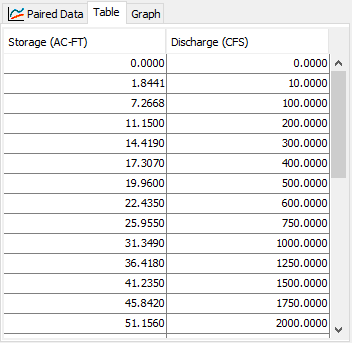
You can enter all of the data one value at a time in the table. However, there are tools to help you enter the data quickly. The table includes support for the clipboard. This means you can copy data stored in a spreadsheet or other file and then paste it into the table. You can also use the fill tool to enter or adjust data values in the table. Select the cells in the table you wish to fill and click the right mouse button. A context menu is displayed; select the Fill command. The Fill Table Options window opens for you to control the process of filling and adjusting cell values. Options include interpolating the values between the first and last cell in the selection, several choices for interpolating and replacing missing values, copying the first selected cell value to all other selected cells, adding a constant value to all selected cells, and multiplying the selected cell values by a constant. Press the OK button to apply your choice, or the Cancel button to return to the table without making any changes.
Graph
The data for the current paired data is shown in graphical form on the Graph tab of the Component Editor. Data in the graph cannot be edited regardless of whether the paired data uses manual entry or retrieves data from an external DSS file. If no data is available, then the graph will not contain any data.
